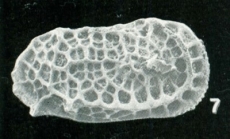Deep-Sea taxon details
Bradleya labyrinthica Whatley, Downing, Kesler & Harlow, 1984
776373 (urn:lsid:marinespecies.org:taxname:776373)
accepted
Species
marine, fresh, terrestrial
Whatley, R.C., Downing, S.E., Kesler, K. and Harlow, C.J. (1984a) New species of the ostracod genus Bradleya from the Tertiary and Quaternary of D.S.P.D.P. sites in the southwest Pacific. Revista Espanola de Micropaleontologia 16, 265–298. [details]
Type locality contained in Lord Howe Rise
type locality contained in Lord Howe Rise [details]
Description Small, moderately robust. Elongate, subrectangular to sub-ovate in lateral view. Anterior regularly convex in RV;...
Etymology L. Referring to the labyrinthine nature of the ornament.
Description Small, moderately robust. Elongate, subrectangular to sub-ovate in lateral view. Anterior regularly convex in RV; asymmetrically so in LV with extremity below mid-height. Posterior distinctly convex. Both margins denticulate with large marginal spine at posteroventral angle. Dorsal margin concave, in LV with spinose anterior hinge ear and large postero-dorsal spine. Ventral margin convex to slightly sinuous. Maximum length at midheight, maximum height at anterior cardinal angle. Reticulum of moderate strength. Ventrolateral ridge of moderate relief with large spine at its posterior termination. Ocular ridge of similar relief, parallel to the anterior margin. Dorsal ridge rather weak and non spinose. Remainder of reticulum rather low. Muri rounded and strongly excavate, moderately numerous with some horizontal and vertical secondary muri. Fossae moderately deep, subquadrate to rounded. Bridge rectangular. Moderately large eye tubercle and ocular sinus. Internal features as for the genus with bilobed posterior hinge tooth in RV. [details]
Etymology L. Referring to the labyrinthine nature of the ornament.
Etymology L. Referring to the labyrinthine nature of the ornament. [details]
Brandão, S. N.; Antonietto, L. S.; Pereira, J. S.; Pereira, S. G. G.; Sá, H. A. B.; Praxedes, R. A.; Sabater, L. M., Santos, S.G.; Karanovic, I. (2025). World Ostracoda Database. Bradleya labyrinthica Whatley, Downing, Kesler & Harlow, 1984. Accessed through: Glover, A.G.; Higgs, N.; Horton, T. (2025) World Register of Deep-Sea species (WoRDSS) at: https://www.marinespecies.org/deepsea/aphia.php?p=taxdetails&id=776373 on 2025-06-03
Glover, A.G.; Higgs, N.; Horton, T. (2025). World Register of Deep-Sea species (WoRDSS). Bradleya labyrinthica Whatley, Downing, Kesler & Harlow, 1984. Accessed at: https://marinespecies.org/deepsea/aphia.php?p=taxdetails&id=776373 on 2025-06-03
Date
action
by
original description
Whatley, R.C., Downing, S.E., Kesler, K. and Harlow, C.J. (1984a) New species of the ostracod genus Bradleya from the Tertiary and Quaternary of D.S.P.D.P. sites in the southwest Pacific. Revista Espanola de Micropaleontologia 16, 265–298. [details]
 Present
Present  Inaccurate
Inaccurate  Introduced: alien
Introduced: alien  Containing type locality
Containing type locality
From editor or global species database
Description Small, moderately robust. Elongate, subrectangular to sub-ovate in lateral view. Anterior regularly convex in RV; asymmetrically so in LV with extremity below mid-height. Posterior distinctly convex. Both margins denticulate with large marginal spine at posteroventral angle. Dorsal margin concave, in LV with spinose anterior hinge ear and large postero-dorsal spine. Ventral margin convex to slightly sinuous. Maximum length at midheight, maximum height at anterior cardinal angle. Reticulum of moderate strength. Ventrolateral ridge of moderate relief with large spine at its posterior termination. Ocular ridge of similar relief, parallel to the anterior margin. Dorsal ridge rather weak and non spinose. Remainder of reticulum rather low. Muri rounded and strongly excavate, moderately numerous with some horizontal and vertical secondary muri. Fossae moderately deep, subquadrate to rounded. Bridge rectangular. Moderately large eye tubercle and ocular sinus. Internal features as for the genus with bilobed posterior hinge tooth in RV. [details]Diagnosis A small, moderately robust, sub-rectangular species of Bradleya with a moderately strong, labyrinthine reticulum. Dorsal margin in LV with strong spine at both anterior and posterior cardinal angles. Ventro-Iateral carina and ocular ridge of equal strength. Bridge well formed, rectangular. Muri moderately numerous, excavate and rounded. Fossae moderately deep, with few secondary muri. Well formed eye-tubercle and ocular sinus [details]
Etymology L. Referring to the labyrinthine nature of the ornament. [details]









